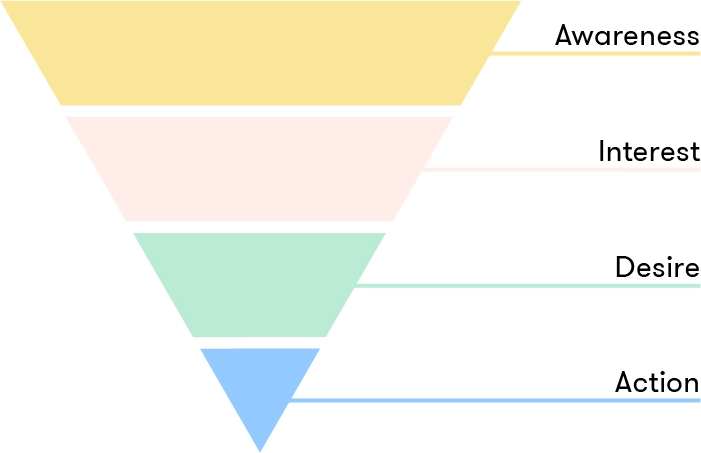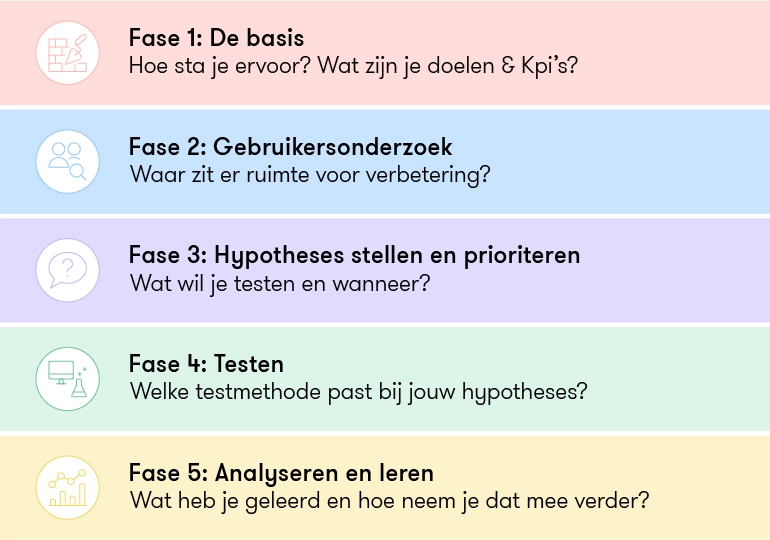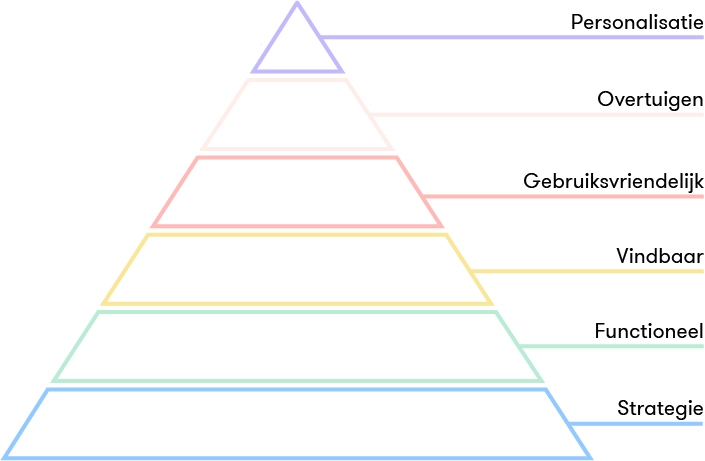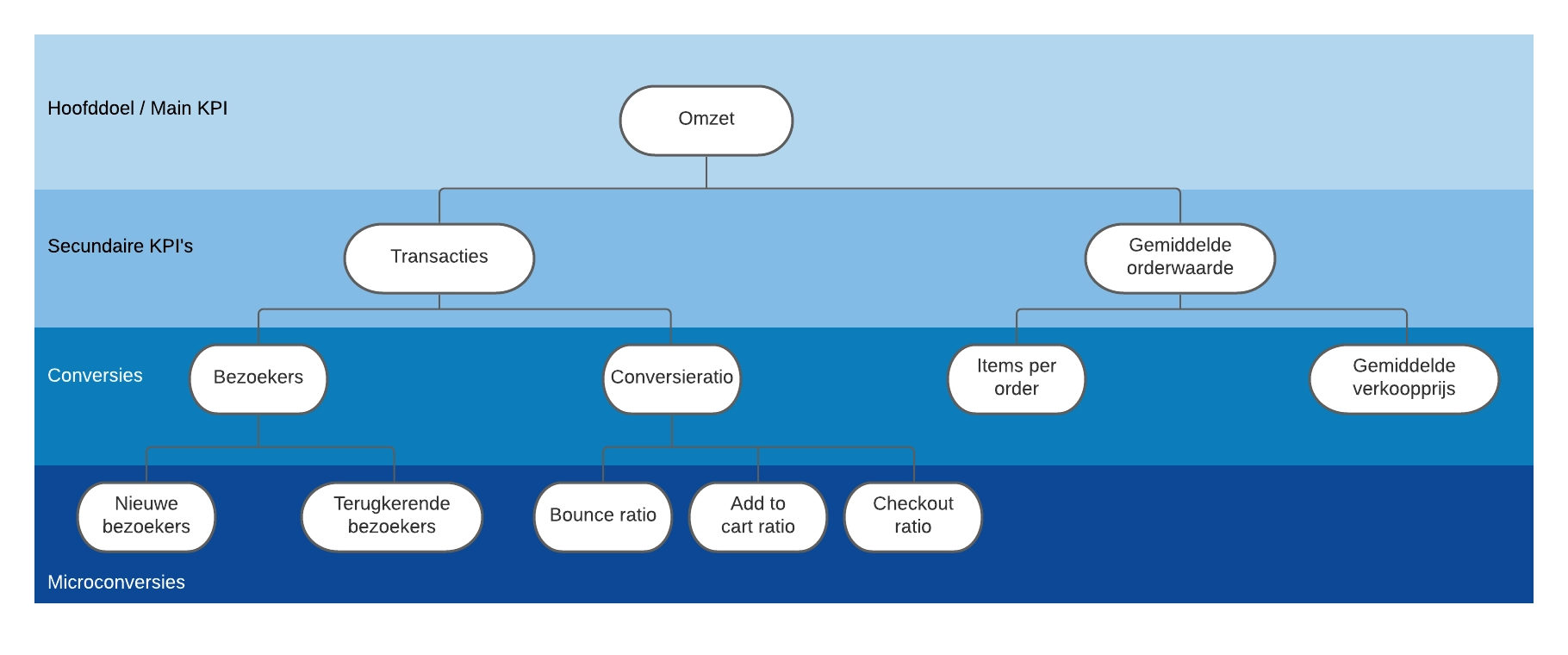What is conversion optimisation? The answer may surprise you, because it's not about simple practical tips, best practices or quick hacks: With conversion optimisation, you make your website work smarter, not harder, with the goal of more customers.
And how do you do that? By understanding your visitors better and finding out what they need (think needs, issues or problems).
In this comprehensive guide, you will learn what conversion optimisation is, why you should use it, how to get started and what tools you can use to increase your conversion rate.
What can you expect from this guide?
This guide consists of 4 chapters. With each chapter, we give you practical tools so you can get started with CRO right away:
What is conversion optimisation?
Conversion Optimisation meaning
Laid flat, conversion optimisation, or conversion rate optimisation (CRO), is a method of increasing the number of visitors who perform a desired action (conversion) on your webshop or website.
A desired action could be, for example, buying a product, signing up for a newsletter or filling in a form.
By using this definition, you lose sight of the most important aspects: people and our behaviour.
At Concept7, we believe that digital products should make people's lives more valuable. So I guess it's no surprise that we have just a different (read: human) take on CRO.
Thus, we see conversion optimisation as a process in which you want to understand what motivates, holds back or persuades visitors on your website.
With the aim of providing the best possible user experience so that ultimately visitors convert more. This approach leads to long-term success and growth.
The result: a rising conversion ratio!
Rather not get started with CRO yourself?
No problem, feel free to contact one of our CRO specialists by sending an email to Sjoerd, Linn or Jildou for a free consultation. Want to know more? Check out our service conversion optimisation.
1. Back to the basics: What is a conversion?
A conversion an action you want a visitor to perform on your website.
Conversions come in many shapes and sizes. Do you sell products on your website? Then a purchase is a conversion. Partly because of these conversions, your sales (hopefully) increase.
You also have a number of interactions or steps that take place before your visitor buys something or becomes your customer. Think, for example, of signing up for a newsletter or someone placing something in his or her shopping basket. These are conversions that you cannot directly measure in money or revenue (or directly say something about that person's purchase intention).
This allows you to differentiate between hard conversions and soft conversions on your website.
Examples of hard conversions
buy product (webshop / ecommerce)
ask for a quote (service / SaaS)
subscribe to a service (think Spotify or Netflix, for example)
Examples of soft conversions
newsletter sign-up (content marketing)
complete contact form (direct contact)
e-book download (content marketing)
The value of different types of conversions depends on what they mean to your business and in which step of the marketing funnel/funnel someone ends up.
For example, you can see every soft conversion as a (small) step towards a hard conversion. Therefore, it is also important to include soft conversions in your conversion optimisation process.
What is the conversion rate and how do you calculate it?
The conversion rate is the number of visitors who perform a desired action on your website. To find out your site's conversion rate, divide the number of conversions by the number of unique visitors or sessions on your website.

What constitutes a good or average conversion rate is difficult to say. This is because:
Conversion rates depend on the purpose of the conversion (clicks on ads, newsletter sign-ups, etc).*
Every website, page and target audience is different.
Companies often do not share this kind of data because it is competitively sensitive.
One thing is certain: a high conversion rate shows how well you connect with your target audience. The higher your conversion rate is, the more relevant you are to your visitors.
* Example: Suppose you have the following conversions: a newsletter sign-up and a product for sale for €1000. The threshold for your visitor to sign up for a newsletter is lower than buying this product. Therefore, the conversion rate of newsletter sign-ups is more likely to be higher than that of purchases.
Conversion tunnel: from soft to hard conversions
Most website visitors will do very little on your site on their first visit. They are still browsing, are still in the research phase or are not sure if what you are offering matches what they need.
It takes time to gain trust and build a relationship. If you know that most of your visitors are not going to convert the first time, it is not smart to push your sales pitch right away. That will put visitors off.
To find out where and how your visitor converts on your website, it is useful to set up a conversion funnel (also called sales funnel or marketing funnel).
When you get off a plane in unfamiliar surroundings, clear signposts help so you know where to go. Similarly, conversion funnels allow you to guide your visitors through your website.
The definition of a conversion tunnel
Hubspot, one of the largest marketing platforms in the world, defines a conversion funnel as a path that potential customers go through before taking the primary action. All visitors start at the top of the funnel. The more convinced they are about your company/product/service, the closer they get to buying (or signing up for) your product or service.
The process is seen as a funnel because you often have more website visitors than people who eventually become customers, making the top of the funnel larger than the bottom.
This allows you to lead visitors step by step from a newsletter submission to a purchase or quote request.

At each step of the funnel, you have information that works as signposts in your customer journey/customer journey. Think articles, landing pages, videos, emails and ads.
By setting up your conversion funnel properly, you can attract potential customers and keep qualified leads warm so that they later convert to customers or users.
Conversie-Checklist:
Make a list of the most important contact moments and interaction moments on your website. Perhaps you can also link that to your conversion funnel.
Note which of these interactions are soft conversions and which are hard conversions.
Is it clear to someone new to your site where they need to click to perform an action?
Do you already measure interactions through Google Analytics (or a similar programme)? Not yet? Then do it 🙂 🙂
Give the conversions a value in Google Analytics, then you can see back which pages played a role in converting.
Keep track of your conversion rate so you can compare it with previous periods.
Look in Google Analytics at where people are dropping out on your website to find out which pages you need to pay attention to.
Want to measure conversions easily? Then use Google Tag Manager, which lets you add enough event tags to your website without dragging down performance (and it's easy too!).
Get more out of your website
2.Why conversion optimization?
At Concept7 we say: “Assumption is the mother of all fuck ups.”
We all know it, assumptions, suspicions and gut feelings. On the one hand, they help us understand the world around us and make quick decisions. On the other hand, they provide us with (often) wrong conclusions or analyses that are not based on anything.
First of all: Don't do something just because your competitor is doing it! It is easy to follow best practices. They are also often written by experts. So why not trust it?
What is often forgotten is that these kinds of best practices arise in a specific context that is different from that of your website. A different purpose, a different target audience and, not least, a completely different design.
What does this have to do with conversion optimisation?
If you have a website, and like getting visitors to your website, then CRO is useful for you. Having visitors on your website convert to customers is important, otherwise you will miss out on sales, simple as that. In that case, it doesn't matter how big your business is. And converting visitors to customers is something you want to do in the most effective, impactful and reliable way.
Therefore, take the time to collect data and analyse it. That way, you can set up tests that are fact-based. And make informed choices. This forms the basis of conversion optimisation.
To make the point even clearer, here's a great quote:
Benefits of conversion optimisation
As you have already realised, we can list a whole list of benefits of conversion optimisation.
1. You understand your visitors better and can respond to their needs
What is the most beautiful and at the same time the most important outcome of CRO is that you get to know your visitors better.
You will find out how your visitors carry themselves on the website, who they are, what they want and what they need.
With this information, you can improve your (potential) customer's user experience and make the website even more relevant to them. As a result, you (warning: repeat!) get more converting visitors. Win win!
2. You make better decisions with lower risk
Before you had heard of conversion optimisation, you probably made adjustments to your website based on gut feelings and assumptions. 🙃
As we mentioned, it's time to make informed choices. With CRO, you can test your gut feelings and assumptions to see if something actually produces results.
Doesn't it work? Then we'll try something else.
For example, by experimenting and evaluating the results, you gain insights to make smarter choices. This way, you make decisions based on data and facts instead of assumptions and conjectures.
This also makes you take smaller risks, because you test first whether something works or not.
3. You increase conversion rates and therefore profits
Conversion optimisation will get you (in the most ideal situation) a higher conversion rate. If you get more results from your existing traffic, you will see that your profits also increase.
Example: 1000 people visit your website and 25 people buy a product for €50. Your conversion rate is then 2.5%. Suppose your cost per product is €30, you get the following calculation:
Sale (25 x €50) | € 1.250 |
Costs (25x €30) | € 750 |
Profit | € 500 |
What happens if you increase the conversion rate from 2.5% to 5%?
Sale (50 x €50) | € 2.500 |
Costs (50 x €30) | € 1500 |
Profit | € 1000 |
By doubling your conversion rate, you also double your profits. But of course, there is a lot involved in this before you achieve this.
3. How do you apply Conversion Optimization?
Where should you start if you want to deploy conversion optimisation? First of all, CRO is a dynamic process, not a linear roadmap or checklist where you can tick off every step and get results immediately. No, with new insights you repeat different stages or steps.

Chamfer 1: de Base
Before you can start, there are a few things you need to pay attention to: the conversion optimisation pyramid and your goals & kpi's. What do you want to achieve and how? This will give you the right tools to guide your activities.
Phase 2: Research
Once you have that in place, it's time for research. What are your visitors doing on your site? Why are they doing it? And importantly, what are they running into?
Fase 3: Hypotheses & prioriteren
The data and insights you get from the research phase form the basis for the next phase: hypothesis generation & prioritisation. This is where you start making choices in what you want to test on your website.
Phase 4: Testing
Next comes testing your hypotheses. Based on the hypotheses, you make adjustments to your texts or design and then test them with your website visitors.
Phase 5: Analyse & learn
Finally, you are going to analyse the results. How did the test version perform against the original design or copy?
Rather not get started with CRO yourself?
No problem, feel free to contact one of our CRO specialists by sending an email to Sjoerd, Linn or Jildou for a free consultation. More information? Check out our expertise conversion optimisation.
Phase 1: Start with the basics, the conversion optimisation pyramid
The conversion (optimisation) pyramid, not to be confused with the conversion tunnel, provides a visual representation of the necessary building blocks of the user experience on a website.
Similar to Maslow's pyramid, website visitors have a number of "basic needs" that must be met before they convert. In other words, to lay a good foundation for long-term growth, it is necessary to optimise your website step by step.
There are a number of different versions of the CRO pyramid, including this one by conversion specialist Martin van Kranenburg, which consists of 5 steps:

As you must have guessed, we have our own take on the conversion optimisation pyramid. We have added some steps and reversed some steps:

By using this pyramid as a starting point for your CRO process, you can make faster and better prioritisations. It may make sense, but before you start personalisation, the website needs to be well put together functionally.
Level 1: Strategy
The website has a clear proposition/value proposition that appeals to a specific target audience. Who is your target audience? What do you want to achieve? How will you achieve this?
Niveau 2: Functioneel
A functionally working site with as few bugs as possible so users don't get frustrated. Is your website technically up to scratch? What are visitors running into on your site?
Level 3: Findable
Your website will be found by the right users in Google or wherever they search. Set up your website for search engine optimisation, focusing on both technical aspects, content and links from other websites (backlinks). What do you want to be found on? Is your website optimised for search engines?
Level 4: User-friendly
Your website is easy to use: there is no friction or uncertainty and your visitor can find what they are looking for quickly and easily. What causes friction? How do you solve it? What are the steps a user can/should go through on your website to do an action?
Level 5: Persuade
Your website increases user motivation to take action. By capitalising on motivators such as greed, fear, status & fulfilment (Tip: Want to know more about motivating the user? Then take the course from Writing for the Brain.)
Level 6: Personalisation
Your website clearly addresses the visitor and you know how the target audience uses your website. This allows you to anticipate needs and questions. How can you address your visitors personally? Can you use tools to automate this process?
Targets, KPIs & baseline measurement for Conversion Optimisation
Okay, you now know roughly where to start optimising. The next step is setting goals. What do you want to achieve with conversion optimisation and how can you make success measurable?
Set clear objectives in line with your business goals and link Key Performance Indicators (KPIs) to them. Linking your KPIs to your business objectives ensures that you are not measuring blindly and irrelevantly.
"Measuring is knowing if you measure the right metrics"
Statistics may not sound human, but by monitoring your goals, whether good or bad, you create an environment where learning is central. You learn more about your users, about your website and about your organisation.
Establishing KPIs
Not all metrics you can measure are relevant as KPIs for your organisation. So which metrics are not KPIs? One rule of thumb used by CXL, the community and trainer on conversion optimisation, is that data that do not directly generate revenue are not KPIs.
In this context, it is useful to distinguish between soft and hard conversions (which we mentioned above). It is important to track hard conversions & statistics, because they indicate which parts of your site need attention and they lay the groundwork for macro-conversions (the steps in the conversion funnel).
If you are a visual thinker, like our conversion specialist Linn, it is smart to set up your KPIs and metrics in a 'goal tree' (aka: goal tree). This allows you to set up goals and make the relationship between them clear.

A goal tree:
helps you focus on what you want to optimise;
breaks up your goals I manageable chunks;
displays the smaller goals and what the impact could be on business objectives;
helps stakeholders see the value of your activities in a language they understand. Think of stakeholders as board members, product owners and shareholders.
Nulmeting
Before you start tweaking your website, it is useful to do a CRO baseline measurement. Look at your KPIs and statistics and note how your website is performing now.
For example, create a dashboard in Google Data Studio so you can quickly and automatically compare periods.
With a baseline measurement, you can keep track of the impact of experiments a adjustments have on your website. Think about growth and development of visitors and their behaviour.

Phase 2: Data collection & research, get to know your users
What do users do on your website, what do they want and why? And last but not least: what are your visitors running into? There are different ways to measure the usage of your website. We distinguish between passive user research and active user research.
In passive user research, you are mainly looking at what users do on your site. You don't actively engage with them, but you collect data through website analysis tools.
On the other hand, you have active user research where you engage directly with your user. These include depth interviews or eyetrack sessions. These research methods help you find out what your (potential) customers' motivations and decision-making processes are.
Passive user research: what are users doing on my website?
Website statistics & data
Programmes like Google Analytics (and other tools) are essential for conversion optimisation. They provide insights into data and into the consumer's lifeworld. This gives you insights that you can convert to optimise your website. Numbers and statistics are precisely tools for understanding your users.
Statistics allow you to make decisions based on facts and figures rather than gut feeling (repetition). These tools give you a huge stream of data. Think about:
information on where your visitors come from;
who visits your website;
and what pages they view.
To arrive at relevant data, it is necessary to filter and analyse this data.
Visitor behaviour
Besides website statistics, you also have analytics tools for visitor behaviour. They create heatmaps and recordings of visitor behaviour. With these tools, you can see how different functionalities or elements on a page influence behaviour. Think Microsoft Clarity, Hotjar or Mouseflow
Inquiries and polls
With surveys and polls on your website, you can ask relevant questions to your visitors (at relevant times) and collect data passively. For example, you can ask for feedback:
why visitors leave your website;
what the visitors bought;
why they bought something or not.
Active user research: what do my visitors want and why?
Besides passive user research, you can also actively approach users. At Concept7, we specialise in user research such as in-depth interviews & eye tracking. With these research methods, we can find out how users experience your website.
Interviews
With depth interviews you gain insight into the motivations and decision-making of your (potential) customers. We then identify concrete areas for improvement that you can immediately use within your organisation and on the website.
Interviews help you decide how to present your product and what you are going to say about your product. If you know why exactly people buy or don't buy a certain product, you can capitalise on this on your website.
Eyetracking
Eye tracking is the process of measuring a user's eye movement on a specific website. With an eyetrack survey, you gain insight into:
Bottlenecks that reduce conversion.
How users scan your website or app.
Which elements attract attention.
Which elements are not seen or perceived.
What people are (looking at).
Insight into motivation and expectations.
UX research & testing
Besides passive and active user research, it is also good to test the usability of your website. You can do this, for example, with an expert review. This is an analysis where a User Experience (user experience) expert, such as our Sjoerd, goes through your website. It helps you form a picture of the usability of your product or service. It gives you insight into bottlenecks and identifies opportunities for improvement.
During the expert review, a usability expert analyses and assesses the usability of the digital product. The analysis and assessment is done on the basis of fundamental principles about usability (the heuristics), knowledge from surveys, own experience and user research.

Phase 3: Hypothesising
What is a hypothesis?
A hypothesis is a substantiated assumption or assumption of how to optimise your website. You formulate the hypothesis before you start experimenting or adjusting your website. Based on all the insights and data you have collected, you can formulate a hypothesis. By experimenting, you start testing whether your hypothesis is correct or not.
Why are they important?
By working with a hypothesis, you can estimate how successful your experiments will be. In the long run, it saves you time by getting better results. Testing for the sake of testing is doomed to fail. An experiment needs a goal to determine whether it is successful or not.
Formulating a hypothesis forces you to think about what that goal is, how to try to achieve it and what kind of results it should produce.
Where a bad hypothesis causes confusion, a good hypothesis provides structure. It is the basis of your experiment, and contains all the information needed to build an experiment/test.
Optimizely says it nicely:
How do you formulate a hypothesis?
To formulate a successful hypothesis, you need five elements:
what you want to change (the problem)
how you are going to change it (the solution / UX, design & Copy)
who you are adapting it for (your target audience)
the desired outcome (KPIs & goals)
why you think it will work (behavioural science / research)
Online Dialogue recommends formulating hypotheses in the same way every time. This creates overlap between the different experiments you conduct and ensures that knowledge stays within your organisation.
Je hypotheses prioriteren
It is impossible to test all your hypotheses at once. Also, your website probably doesn't have an infinite number of visitors on which to test your hypotheses. Therefore, it is necessary to prioritise all these ideas so that you can start with the hypotheses with the most potential. And so that the bad ideas don't get attention or the wrong pages are targeted.
There are many different ways to prioritise your hypotheses. The three most well-known are the PIE model, the ICE model and CXL's PXL model.
PIE
With the PIE model, you give the hypothesis a score based on how much potential the adaptation has, the importance of the page on which the adaptation happens and how easy it is to implement.
Potential - What is the potential of this page?
Importance - How valuable is the traffic to the pages? (amount of traffic etc.)
Ease - How easy is it to implement the test on the page?
ICE
Like the PIE model, the ICE model allows you to score your hypothesis based on 3 points.
Impact - What is the expected effect?
Confidence - How confident am I that it will work?
Ease - How easy is it to implement?
Ease - How easy is it to implement?
PXL
CXL's PXL model is different. They find the PIE and ICE models too subjective, and try to create an objective way of prioritising with their model. Instead of scoring on three points, CXL has set a number of criteria:
Is the change above the fold?
Does the change stand out within 5 seconds?
Are you adding an element or removing one?
Is it designed to increase user motivation?
Does it take place on a high-traffic page?
Is it addressing a problem you discovered during user research?
Is your hypothesis supported by heatmaps or eye tracking?
How easy is it to implement? (measured in hours)


Phase 4: Experimenting with conversions
Time for action! You have prioritised the hypotheses and now it is time to see if the hypotheses match reality. If not, you can update them and test again.
When you run an experiment, such as an A/B test, you test one variant against another to see which yields more conversions, leads or sales. Half of your visitors get to see variant A, and the rest variant B. Some versions will yield better results and validate your hypothesis. As a result, you will always have winning and losing tests.
Have no fear, even from losing tests you can learn something. From these tests, you will also gain valuable insights into your target audience's behaviour. You can use these to improve future experiments.
Depending on your hypothesis, website traffic and goal, you can choose between different types of experiments:
A/B-test
Multivariate-test
Split URL-test

Phase 5: Analysing & Leren
In this 'final' phase of the CRO process, you will analyse the results of your experiments. What can you learn from the tests? How did they perform?
Besides using results from your experiments tool to evaluate your tests it is also smart to use Google Analytics.
Even if your test has produced good results, it is still useful to ask some questions:
What was the cost of implementation (technology & design)?
What is the balance between the expected increase in revenue and the cost of implementation?
What do you do if the results are ambiguous?
go back to previous research and insights to re-analyse the data
check whether your hypothesis has been formulated well enough
look at the performance of different segments in Google analytics
formulate your hypothesis again following your new insights
Conversion optimisation is not a linear process, it is better described as a cycle. It is a continuous process that requires new analysis. A well-designed CRO process helps you identify areas for improvement.
4. The 18 best conversion optimization tools
To make life a little easier for you, we have compiled a list of our 15 favourite conversion optimisation tools that we use.
However, as Hotjar also says, the best optimisation tools are free! The most important tool you need to better understand your customers and empathise with their user experience is you yourself (thinking, listening, watching and asking 🙂 ).
SEO / Findability
MOZbar - quick check of website authority and whether all metadata is properly populated - Free version
SEMrush - SEO audit tool - Free version lets you analyse a website
Screaming Frog - SEO audit tool - Free version lets you analyse 500 URLs
Lighthouse - Chrome extension to check your page speed and other SEO (can also be done via Inspect tool) - free
Google Page Speed - check your website's page speed - free
Yoast SEO - SEO check for content - free plugin for WordPress
Behavioural analysis
Hotjar - create heatmaps & recordings of your visitors, ask them questions via surveys - free version available
Mouseflow - create heatmaps & recordings of your visitors, ask them questions via surveys - free version available
Experience
Google Optimize – A/B tests, Multivariate tests – gratis tool
Optimizely – A/B tests & multivariate tests – betaald account
VWO – A/B tests, Multivariate tests – betaald account
Convert.com – A/B tests, multivariate tests split tests – betaald account
Statistics & Analysis
Google Analytics - analyse website statistics - free
Klipfolio - create dashboards - free version available
Google Data Studio - create dashboards to visually display website statistics - Free
Tracking insights
Excel / Google sheet
Getting started with conversion optimisation?
Meld je aan voor onze nieuwsbrief en ontvang maandelijks praktische inzichten, tips en tricks om je op weg te helpen naar online groei!
Vul hieronder jouw e-mail in en ontvang direct een handig weetje 🙂

